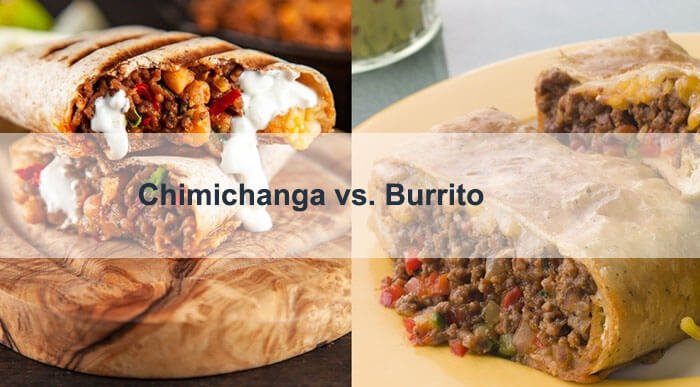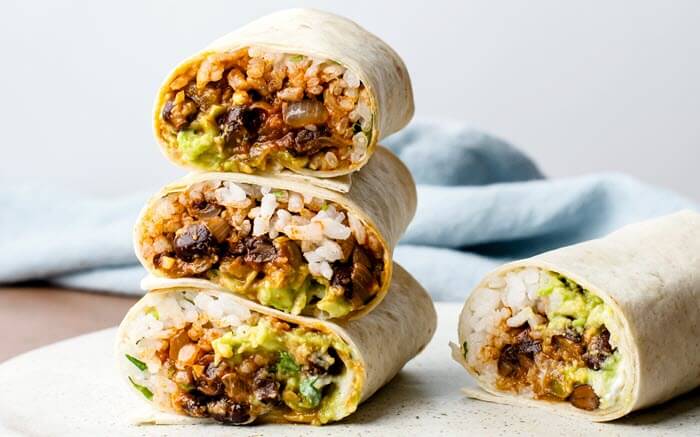It’s a question that many ask: what’s the difference between a burrito and chimichanga? You may think that they’re the same thing, but they’re not!
Let’s take a look at the differences — some of them subtle, and some not so subtle — between these two culinary delights!
By the time we’re finished, you’ll have a good idea of the differences so you know what to order when you have a taste for Tex-Mex.
Table Of Contents
What is a Chimichanga and Burrito?
What is Chimichanga?
A chimichanga is a deep-fried wheat tortilla with fillings, or as some people call them, deep-fried burritos. Inside is a mix of meat, beans, rice, cheese, vegetables, and sauce.
Origin Of Chimichanga
Chimichanga originated in the United States, most likely in Arizona.
Legend has it that the chimichanga was invented at the El Charro Cafe in Tucson in 1922 when Tia Monica Flin accidentally dropped a burrito into a deep fryer. She was going to call it a “thingamajig,” but since that was a swear word in Spanish and kids were around, she called it a “chimichanga” instead, which means “toasted monkeys.”
A conflicting account says it was invented in 1946 at Macayo’s Mexican Restaurant in Phoenix by Woody Johnson, who fried unsold burritos to sell the next day. Because the fried burritos were light brown in color, Woody named them after “changas,” little brown monkeys.
While Woody Johnson sold the rights to his restaurant a few years ago, the El Charro Cafe is still in business and claims on its website that Tia Monica Flin was indeed the true inventor of the chimichanga.
What is Burrito?
A burrito is a flour tortilla that contains a delicious mix of beans, vegetables, rice, cheese, sauces, and meats.
The fillings are placed in the middle, and the tortilla is then folded over to seal the edges.
Traditional Mexican burritos are on the smaller side and traditionally only included one or two ingredients, such as beans and vegetables.
Origin Of Burrito
Burrito originated in Northern Mexico. The word burrito means “little donkey” in Spanish.
Folklore has it that the man who invented burritos owned a small donkey who accompanied him on the days he prepared and sold burritos.
Another legend has it that another man invented burritos by feeding them to hungry middle school children that he called “little donkeys.”
Chimichanga vs. Burrito: the Differences
1. Serving
Chimichanga
Chimichangas, which are pan-fried, deep-fried, or air-fried, are usually served smothered in sauces with sour cream and guacamole on the side.
Chimichangas are crisp and have a bit of crunch to them compared to the soft burrito. They are served hot on a plate and are best eaten with a fork and knife.
Burritos
Burritos are often served cold or warm, whereas chimichangas are served hot.
Because burritos are served colder, cheese, creams, salsa, and other sauces can go on the inside, whereas they would melt in chimichangas.
Burritos are often wrapped in foil, but not always; they may be served looking like a “wrap.” They are most often eaten by hand.
A variation is the “wet burrito,” which is served on a plate with sauces on top. These are better eaten with a knife and fork.
2. Ingredients
Chimichanga
Chimichanga tends to have more meat in them than burritos.
Using meat as the main ingredient, the tortilla may also have rice, vegetables, beans, and cheeses added to it before it is sealed and fried.
In some cases, the beans are served on the side.
Burritos
North American burritos are different from those served in northern Mexico in that they are larger and filled with more ingredients.
However, restaurants in California and Texas do serve burritos that resemble Mexican burritos, with a mound of refried beans and seasonings resembling chili.
Most North American burritos today resemble the burrito you can buy at restaurants like Chipotle.
They are on the larger side and contain ingredients like chicken, beef, rice, lettuce, fajita vegetables, cheese, and sauces.
3. Taste
The taste between the burrito and the chimichanga does differ a bit, but again, it depends on the ingredients.
4. Nutrition
A 6.5-ounce chimichanga with beef and cheese contains 11.2 grams of saturated fat, more than half the daily value, as well as 51 milligrams of cholesterol.
But this doesn’t mean you have to give up chimichanga!
Chimichanga can provide nutritional value, especially if lean ground beef or turkey and low-fat cheeses are used, which provide protein and calcium.
It’s also high in sodium, containing 42% of the daily sodium value.
To limit additional sodium, be careful with the side dishes served with chimichangas.
For example, serve beans and chopped tomatoes on the side instead of tortilla chips, sour cream, and enchilada sauce.
Chimichangas vs. Burritos: Which One is Better?
Chimichanga | Burrito | |
Origin | Arizona | Northern Mexico |
Preparation | Deep-fried | Served cold/warm |
Serving | Served on a plate | Wrapped in a foil |
Sauces | A lot of sauce on top | Served without sauce |
Filling | More meat | More vegetables (beans and veggies) |
Health | Unhealthy | Healthier |
Regarding which of the two is better for you, the burrito wins.
Again, it depends on the ingredients you select. A bean and vegetable filling will be healthier than a burrito stuffed with beef, cheese, sour cream, and guacamole.
If you were to place a burrito and a chimichanga next to each other on a plate, you would notice a few things:
- The burrito is lighter in appearance than the chimichanga. The burrito has a whitish appearance, whereas the chimichanga is light brown from being fried.
- The burrito is softer than the chimichanga — the burrito is wrapped in a soft flour tortilla, whereas the chimichanga is crunchy from being fried.
- Slicing into the burrito, you would find that it is easier to cut than the chimichanga, again due to the frying.
- Once sliced open, you would find the chimichanga ingredients to be hot and melted, whereas the burrito ingredients are cold and more compacted within the tightly wrapped tortilla.
FAQs About Chimichanga and Burrito
Is a chimichanga just a fried burrito?
A chimichanga is a deep-fried burrito. But the fillings of them are different. The filling of a chimichanga contains more meat while a burrito contains more vegetables.
Burritos, enchiladas, and chimichangas: what’s the difference?
A burrito has a flour tortilla wrapped around fillings that vary quite a lot. Enchidlas have corn tortillas that wrap around meat, and are usually served with a lot of sauces. Chimichangas are deep-fried burritos.
Also read: Difference Between Chimichanga and Enchilada
Chimichanga vs Burrito Conclusion
So there you have it — the differences between burrito and chimichanga. Depending on what you put in them, burritos will be the healthier option between the two.
However, if you’re craving something hot and crispy with belly-warming melty cheese, chimichanga might just be the thing. If you eat them only once in a while, they can make an extra special treat!
No matter which of the two you choose, you are in for a delicious meal with a tasty burrito or chimichanga!



